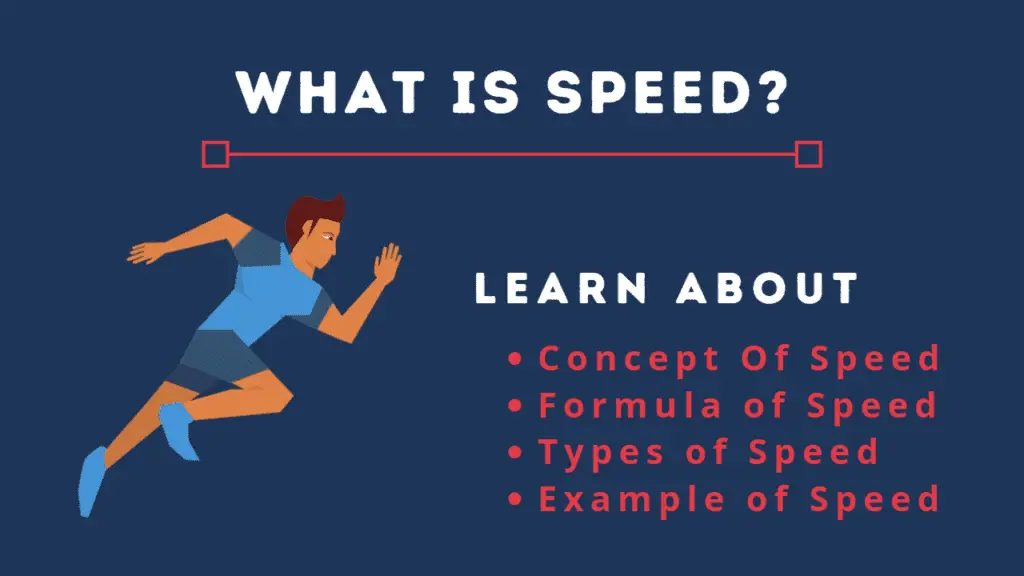Concept of speed is one of the first concepts when we start studying physics. The concept of speed is discussed under kinematics. In this article, we will learn about the concept of speed, its formula, unit along with some examples. Let us first begin by defining speed.

Definition of Speed In Physics
The distance travelled per unit of time is referred to as speed. It is the rate at which a body moves.
Speed is a scalar quantity that is nothing but the magnitude of the velocity vector. Since speed is a scalar quantity it only has magnitude but no direction.
It must be noted that
- A higher speed indicates that an object is travelling fast.
- If the object is travelling slowly then it has a lesser speed.
- Object under consideration has 0 speed if it is not moving at all.
See Also: Difference between Speed and Velocity
Formula for speed
In order to calculate speed, you divide the distance traveled by the amount of time it took you to cover that distance.
If s is the speed of the object and d is the distance covered by that object in time t then the formula for speed is given by the relation
$$s=\frac{d}{t}$$
The above equation computes an object’s average speed over time. During its course of motion, the object may have been going faster or slower at different points of time during the given time interval. What we see here is the average speed of the object.
See Also: Distance and Displacement
Unit of Speed
In the SI system of units, speed is measured in meters per second (m/s) (meters per second). In general day-to-day usage, the units of speed are kilometers per hour or miles per hour.
In the CGS system of units speed is measured in centimeters per second (cm/s).
| System of Units | Unit of speed |
|---|---|
| CGS | centimeter per second $(cm\cdot s^{-1})$ |
| SI | meter per second $(m\cdot s^{-1})$ |
| non-SI metric | kilometer per hour |
| Imperial & US customary | mile per hour $(mph) $ mile per second $(mi\cdot s^{-1}) $ foot per second $(ft\cdot s^{-1})$ |
Types of Speed
There are four types of speed and they are:
- Uniform speed:- When an object travels the same distance in the same time intervals, it is said to be moving at a uniform speed.
- Non-Uniform or variable speed:- Non-uniform speed occurs when an object covers a unequal distance at equal intervals of time.
- Average speed:- The average speed of a body over a certain time interval is equal to the distance travelled by the body divided by the time.
- Instantaneous speed :- The instantaneous speed of a particle is the speed of the particle at any instant of time or at any point on its path. It tells us about how fast an object is moving anywhere along its path. When you look at a speedometer in a car, you are seeing the instantaneous speed of the car.
Measurement of Speed
Speedometers are used in automobiles to measure speed. Odometers are used to track the distance traveled.
While solving problems in graphs can also be used to calculate speed. The Position-time graph aids in understanding an object’s speed. We can find average velocity on a position-time graph. Apart from this, we can also use a position-time graph for finding instantaneous velocity.
Examples of Speed
Let us now look at some examples of speed.
| Moving Object | Speed |
|---|---|
| Speed of light in vacuum | 3\times 10^8m/s |
| Speed of Earth rotating around the sun | 30 kilometers per second, or 67,000 miles per hour |
| Speed of sound in air | At 20 °C (68 °F), the speed of sound in air is about 343 meters per second |
| Speed of airplane | It depends on the type of airplane. A commercial airliner like the Boring 777 or Airbus A320 flies at 800 to 950kmph. |
| Speed of ballistic missile | around 24,000 kilometers per hour (or, 15,000 miles per hour) |
